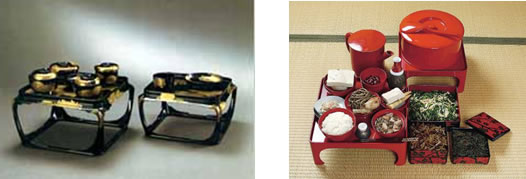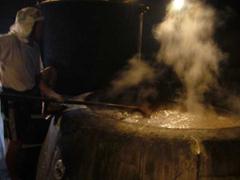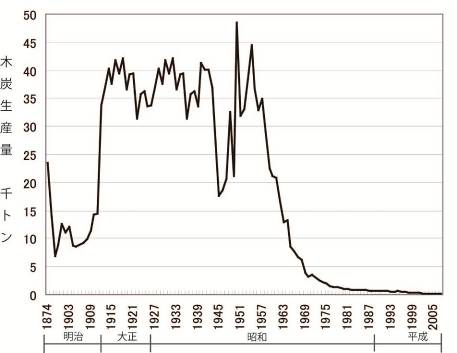Traditional Crafts and Technologies
Processing techniques for agricultural and marine produceIn Noto, day-to-day knowledge of how to preserve freshly harvested agricultural and marine produce for an extended period of time is still passed down through the generations. It is the accumulated wisdom of Noto’s forebears that has enabled the bounties of the Satoyama and Satoumi systems to be deliciously preserved and safely eaten. People have refined their methods of preservation from long ago when there was no technology such as refrigerators or canning facilities. There are three main methods of extended food preservation – drying, pickling and fermentation, or a combination of these. Pickling using salt or other seasonings increases the salt content in the food, and the lactic acid or alcohol produced during fermentation also works as a preservative.
Drying techniquesNoto has a warm humid climate and thus preserving fresh food was difficult. Furthermore, there was a necessity to accumulate food supplies for the winter when snow covered the ground for long periods. As a result, the practice of drying was developed, to preserve the large amounts of agricultural and marine produce available through the seasons – and drying is still part of life in Noto today.
The water content in fish is around 70-80%, and since self-digestion is rapid, leading to rotting, it is necessary to preserve fish so the water content is below 40%. Drying reduces the water content and creates a ‘skin’ on the surface of the fish, making preserving easier. Drying also creates a unique texture and taste. The wind/air is important in dried food production, and it is necessary to achieve just the right amount of moisture at the right temperature. The sea breeze that blows in the Noto coastal areas and the wind from the satoyama areas is indispensable to dried food production. The people who make dried foods know the winds that are best for drying, and have attached the names ‘Sagari no kaze’ and ‘Ae no kaze’ to the seasonal winds that blow dry wind up from the south and winter winds from the Northwest. There are a range of dried foods, including drying the food as-is in the sun (called natural drying or suboshi), removing some of the water content (called overnight drying (ichiyaboshi) or fresh drying (namaboshi)), drying after gutting the fish (whole drying or maruboshi), drying after soaking in a pickling solution (pickle drying or chomiboshi), and drying after pickling with salt (salted drying or shioboshi). In Noto, one unique method of pickle drying is fish sauce drying (ishiruboshi).
Not only marine produce but also agricultural produce is dried for preserving. The common pickle known as takuan (pickled daikon radish) starts with drying the daikon. In Shika Town and other places, dried persimmon called ‘korogaki’ or ‘turned persimmon’ is a local specialty. It is said that the name came about because the persimmons are turned over and over in full sun to dry. Dried persimmons, which are made carefully by drying in the sun for a long period, are the result of the wisdom of Noto’s forebears.
Table II-3-1: Foods dried in Noto - by season
Pickling and fermentation techniquesProcessing techniques for extended preservation of the bounties of Satoyama/Satoumi include the method of pickling a variety of agricultural and marine produce in various pickling solutions for a specified amount of time. The pickling time varies from several minutes to even decades. For long periods of pickling, it is common for fermentation to occur also. Food processing techniques are influenced by the climate of the area. Noto’s summer is hot and humid, and so it is not unknown for the food to go off before the water content has been removed in the preserving process. As a result, food fermentation techniques developed to make use of the power of microorganisms, and thus fermented foodstuffs are plentiful – so much so that the area has been called ‘Fermented food heaven’.
Fermentation techniques include the use of traditional seasonings such as sake and miso, fish sauce (ishiru or ishiri) and soy sauce, but in addition, the power of lactic acid and alcohol which are by-products of the fermentation process, are used to deliciously preserve a range of foods. In recent years, fermented foods have attracted attention for their active ingredients, and the techniques themselves are essential to making health-conscious food.
In the present day, fermentation is widely known to be the result of the action of microorganisms, but in the olden days, the people simply knew from repetition that ‘I don’t know why, but by carrying out this process, the appearance of the food changes in a similar way each time’. That change has become revered as the working of the Gods. Even today, it is the reason for Sake breweries to hang shimenawa (sacred braided rope) or to have a Shinto altar on site.
Noto has always had a wide variety of fermented foods, but with modernization came the ability to gradually identify the fermentation mechanisms, and thus with constituent analysis and clarification of their functions, the value and effectiveness of traditional fermented foods has been increasingly demonstrated. In recent years, initiatives have been taken to actively promote Noto’s fermentation culture, so that traditional fermentation techniques and cultural aspects, including religious beliefs, are passed down to the next generation.
Traditional artsWajima lacquer wareIn Noto, the dishes used on celebratory days such as ceremonial occasions are Wajima lacquer ware. Typically these are the solid lacquer bowls, and lacquered solid red furniture (such as individual tables). For Buddhist occasions the red lacquer ware is used (for memorial services on the 49th anniversary of death, black lacquer ware is used), and on celebratory occasions, black lacquer ware is used. Wajima lacquer ware is made very solidly since the farming and fishing families tended to have strong religious beliefs and cherish their possessions, and thus expected the lacquer ware to last for a long time – so much so that lacquer ware was often amassed over several generations. Black lacquer ware is called ‘black furniture’ which is as commonly available as the red lacquer ware ‘red furniture’, but since people tended to buy the red furniture on a regular basis, homes don’t tend to have as much black furniture.
Since the use of this type of lacquered furniture is limited to celebratory days such as weddings (black), Buddhist memorial services (red), Buddhist ceremonies (red), and funerals (red); other types of celebratory days use everyday dishes. Furthermore, for the Buddhist monk overseeing memorial services, a red lacquered individual table called a kakeban or choashizen was often used, and it was common for people to borrow these for the occasion.
Wajima lacquer ware pieces are made with an emphasis on strength, by starting with a thick piece of wood then strengthening it with cloth, followed by painting on layer after layer of a thick lacquer preparation made with crude urushi lacquer, rice glue and burnt diatomaceous earth. Thus with the time and effort taken to add more than 75 layers of lacquer, and more than 120 days needed for production, the lacquer ware is very valuable.
In 1975, Wajima lacquer ware was designated as a ‘Traditional Art/Craft’ by the Ministry of International Trade and Industry (now known as the Ministry of Economy, Trade and Industry). In addition, in 1977 it held a particularly important position in the history of arts and crafts as well as it being notable for its regional flavor and high artistic value, and was thus designated as an Important Intangible Cultural Property. Furthermore, the Society for the Preservation of Wajima Lacquer Ware Techniques (consisting of artisans experienced in the lacquer processes along with academic experts) has been designated as a Preservation Group for Techniques of Important Intangible Cultural Properties.
Photo: Wajima Lacquer Ware – Black furniture Photo: Wajima Lacquer Ware – Red furniture
|
 |
     Loading
|

























